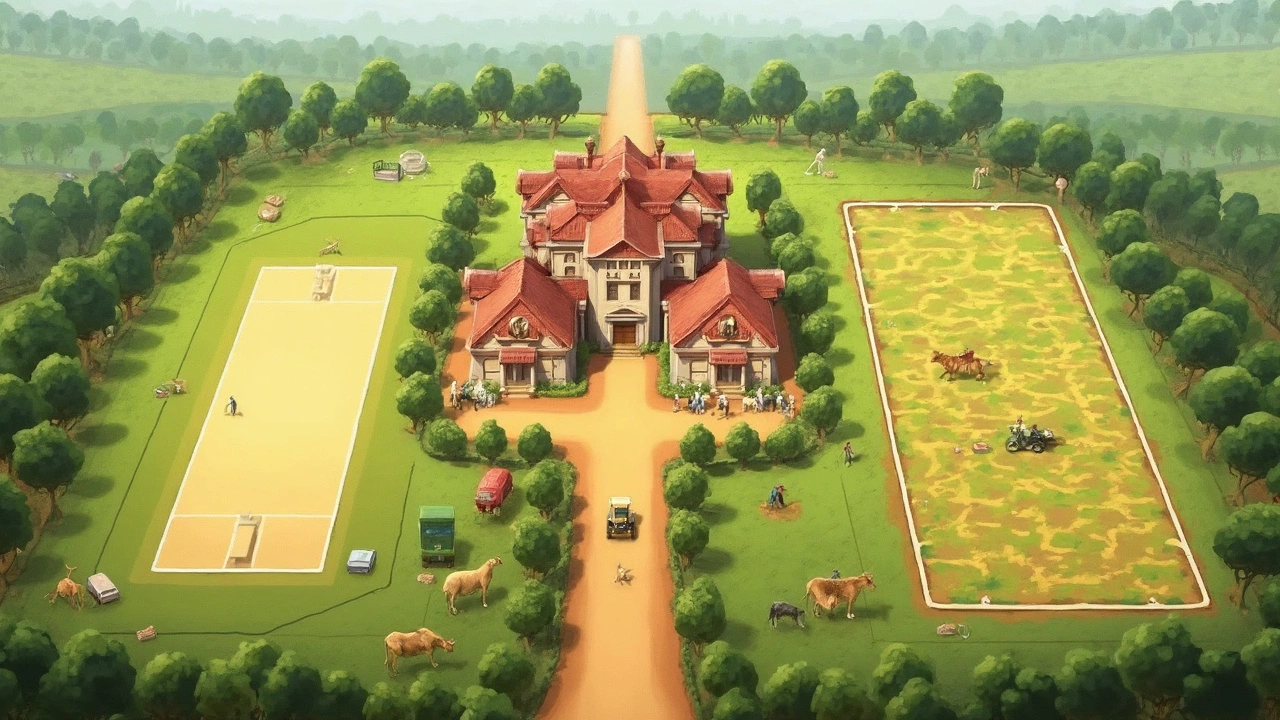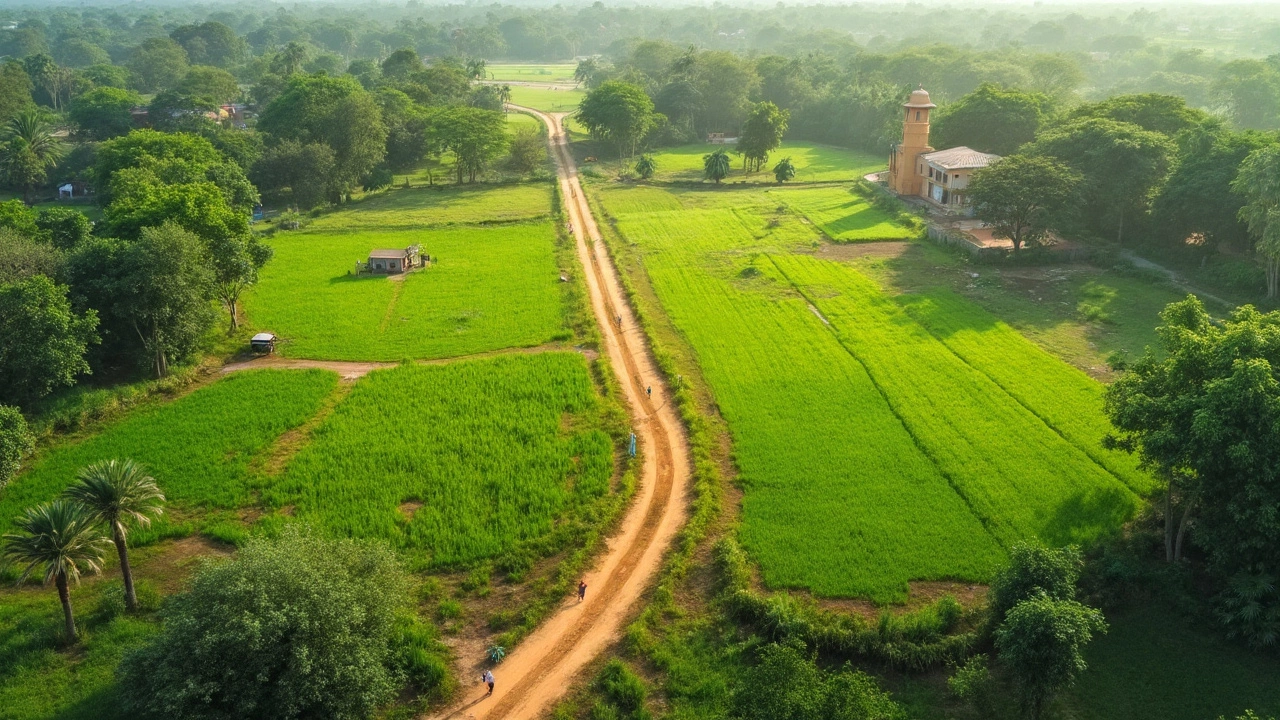If you’re checking out land for sale, you’ve probably seen listings bragging about “10 acres!” But what does that even look like in real life? Forget the textbook definitions—let’s break it down so you can picture it before you hop in the car.
Most folks hear “10 acres” and nod, but when you ask, ‘How wide is that?’ you’ll see puzzled faces. Sure, 10 acres is 435,600 square feet. But that number doesn’t feel real until you put it into something you can imagine, like a football field or a city block. If you’re planning to buy, build, or just daydream about what fits on this much land, getting a grip on the actual layout makes a world of difference.
- What Does 10 Acres Look Like?
- Measuring the Width and Dimensions
- Comparing 10 Acres to Everyday Spaces
- Common Uses for 10 Acres
- Tips for Buying and Using 10 Acres
What Does 10 Acres Look Like?
When people ask about land, they really want to see it in their heads. So, let’s picture 10 acres in plain terms. First off, 10 acres is a chunk of land equal to 435,600 square feet. But that number doesn’t help much when you’re out standing in an open field.
If you walked around a perfect square of 10 acres, each side would be about 660 feet. That’s about two city blocks. If you had a measuring tape (and endless patience), laying it out would look something like this:
| Shape | Width (ft) | Length (ft) | Total Area (sq ft) |
|---|---|---|---|
| Square | 660 | 660 | 435,600 |
| Rectangle | 500 | 871.2 | 435,600 |
| Rectangle | 330 | 1,320 | 435,600 |
When you’re standing at one end of this land, looking down 660 feet, that’s about the length of two football fields, end to end. If the land’s more of a rectangle (and most parcels for sale aren’t perfect squares), one common shape is 660 feet wide by 660 feet long, or it could be skinnier and stretch out farther—think 330 feet wide by 1,320 feet long.
Here’s another way to see it. Imagine 7.5 full-size football fields lined up together. That’s about the coverage you’d get on 10 acres, all without the crowds or loudspeakers. It’s a lot of ground to call your own and you’ll get your steps in walking around it.
The layout of your land matters. A wider plot is better for placing a house with a huge yard. A longer one gives you space for crops, animals, or maybe even a private trail. Check the actual shape on the map, not just the size, because a couple hundred feet can really change how usable the land feels.
Measuring the Width and Dimensions
When people ask about the width of 10 acres, the answer depends on the shape of the land. Most properties aren’t perfect squares, but let’s use a square and rectangle for clear numbers.
A 10-acre square would be about 660 feet wide on each side. To picture this, walk about two football fields end to end—that’s pretty close. If the land is rectangular, the width and length trade off, but the total area stays at 435,600 square feet.
Here’s a quick cheat sheet so you can compare different shapes:
| Shape | Width (ft) | Length (ft) |
|---|---|---|
| Square | 660 | 660 |
| Typical Rectangle | 330 | 1,320 |
| Football Field (comparison) | 160 | 360 |
Of course, in the real world, 10 acres can be chopped up into almost any shape, which messes with the width and length numbers. Sometimes you’ll see long, narrow parcels that stretch out like a driveway—great if you want road frontage, not so great for privacy. Or maybe it’s short and wide, perfect for a build closer to the main road.
If you ever want to measure for yourself, walk the perimeter with a measuring wheel or use an app that works with satellite view. A lot of folks just pace it out—one average step is about 2.5 feet.
- If the seller lists the shape, always ask for a survey map—it pays to know what you’re buying.
- Double-check if local zoning rules require a certain width for building.
- Use google maps or an aerial view to get an honest feel for the dimensions—don’t just trust the numbers on the listing.
Width matters, whether you’re thinking about a driveway, a home, or splitting up the land later. Take time to really see the layout in person if you can.

Comparing 10 Acres to Everyday Spaces
Trying to picture 10 acres? The numbers are nice, but let’s get real. Ten acres is way bigger than most backyards, but it’s not a ranch either. Let’s break it down with things you see every day.
First off: A standard American football field, including the end zones, is about 1.32 acres. That means you could fit more than seven and a half football fields side by side on a 10-acre plot. That’s a lot of space to toss a ball or build homes.
| Landmark | Size (Acres) | 10 Acres Equals |
|---|---|---|
| Football Field | 1.32 | 7.6 fields |
| Soccer Field (pro) | 1.76 | 5.7 fields |
| City Block (typical US) | 2.5 | 4 blocks |
| Baseball Field (outfield) | 3 | 3.3 fields |
If you lined up four regular city blocks, you’d have roughly 10 acres. That’s enough room to fit a small neighborhood’s worth of houses or to plant a ton of trees. Imagine all the space between those city intersections—that’s your 10-acre spot.
Here’s a cool trick: an acre is about 208.7 feet on each side if it’s a perfect square. So, 10 acres in a square shape is about 660 feet wide and 660 feet long. That’s over two football fields put side by side, both ways. If you walk the perimeter, you’ll cover half a mile.
Having a visual really helps when you’re standing on a big open field. If you’re scouting land or talking to an agent, knowing how it measures up to fields or blocks makes it so much easier to really understand the space.
Common Uses for 10 Acres
So what can you actually do with 10 acres? This size gives you room to play with all kinds of options—way more than just a big yard. Most buyers look at land size first to match what they want to do, so here’s how 10 acres stacks up in the real world.
If you love the idea of a hobby farm, 10 acres checks the boxes. There’s space for a couple of homes, barns, sheds, and even a small orchard or garden. With the right setup, you can keep some horses, a herd of goats, or a bunch of chickens without feeling cramped. It’s also plenty for growing crops (think corn, soybeans, or hay for your animals) if you’re into agriculture.
Some folks split their property for multiple uses. It’s not uncommon to see half the land as pasture, a couple of acres for buildings and driveway, and the rest for woods or a pond. If you’re looking at a business or recreational angle, 10 acres fits gun ranges, paintball fields, or even tiny home parks if zoning allows.
For those curious about numbers, here are examples of what fits comfortably on 10 acres:
- Up to 4 full-size soccer fields with room for parking.
- Building two or three roomy homes, plus large yards.
- Small vineyards usually start at 5 acres, so you can grow a lot of grapes here.
- A solar array that can power multiple homes or a farm setup.
| Use | Approximate Area Needed | Possible on 10 Acres? |
|---|---|---|
| Standard Football Field | 1.32 acres | Yes, 7+ fields |
| Small Family Farm (barn, house, garden) | 3-6 acres | Yes |
| Horse Pasture (5 horses) | 8-10 acres | Yes, with rotation |
| RV Campground (20 sites) | 5 acres | Yes |
| Mini Solar Farm | 2 acres | Yes, plus space for more |
If you’re aiming for privacy or long driveways, 10 acres means you can set the house far from the road and still have space for woods or trails. It’s also more than enough for serious gardening, a couple of ponds, or even private dirt bike tracks. Just remember to check local rules—zoning can make or break your plans.

Tips for Buying and Using 10 Acres
If you’re serious about landing 10 acres, you want to avoid rookie mistakes. The first thing—don’t just look at the number on the listing. Look at the shape and dimensions. Two plots can both be 10 acres, but one might be wide and shallow, while another is long and skinny. That can totally change what you can do with the land, especially for stuff like building a house, parking equipment, or farming.
Always check land size details with a survey. Don’t just trust what’s written online or on a sign. If the land hasn’t been surveyed in a while, ask for an official survey before you buy. This gives you clear boundaries and can save you from legal headaches. And if you’re thinking about running livestock, putting in a pool, or building outbuildings, double-check the zoning rules. Zoning can limit what you can do—sometimes way more than you’d expect.
- Make sure there’s easy access to water and utilities—bringing these in later hikes up costs.
- Find out if there are any easements or rights-of-way. Sometimes utility companies (or neighbors) have legal use of part of your land.
- Visit at different times of day to check noise, traffic, or flooding after rain.
If you’re hoping to farm, raise animals, or plant an orchard, test the soil or look at farm history in the area. Some land is better for crops; others are rocky or prone to flooding. Want to split the land or build for rental? Dig into local rules, because some counties have strict limits on dividing up your lot.
| Check Before Buying | Why It Matters |
|---|---|
| Legal Survey | Confirms boundaries and helps avoid disputes |
| Zoning Restrictions | Decides what you can or can’t build |
| Water/Utilities Access | Saves cash and headaches down the road |
| Soil Quality | Makes or breaks farming or gardening plans |
| Easements | Avoids surprise claims on your land |
Don’t just daydream about what you could do with 10 acres—write down your priorities and compare them with what the land actually offers. And if you’re new to land buying, working with a real estate pro who knows rural property can save you from rookie regret. Good land doesn’t stay on the market, so act quick—but never rush past the details.

